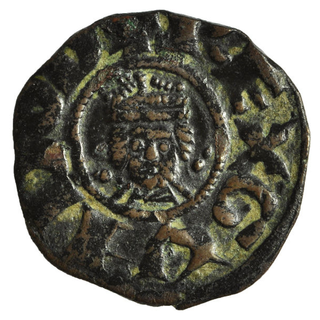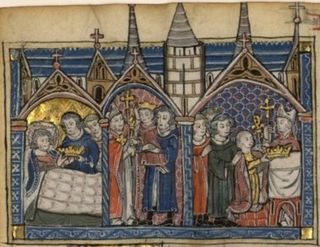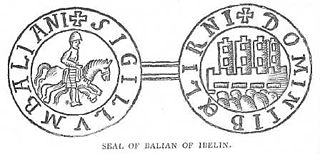Related Research Articles

Aimery of Lusignan, erroneously referred to as Amalric or Amaury in earlier scholarship, was the first king of Cyprus, reigning from 1196 to his death. He also reigned as the king of Jerusalem from his marriage to Isabella I in 1197 to his death. He was a younger son of Hugh VIII of Lusignan, a nobleman in Poitou. After participating in a rebellion against Henry II of England in 1168, he went to the Holy Land and settled in the Kingdom of Jerusalem.

William of Tyre was a medieval prelate and chronicler. As archbishop of Tyre, he is sometimes known as William II to distinguish him from his predecessor, William I, the Englishman, a former prior of the Church of the Holy Sepulchre, who was Archbishop of Tyre from 1127 to 1135. He grew up in Jerusalem at the height of the Kingdom of Jerusalem, which had been established in 1099 after the First Crusade, and he spent twenty years studying the liberal arts and canon law in the universities of Europe.

Guy of Lusignan was a French Poitevin knight who reigned as the king of Jerusalem from 1186 to 1192 by right of marriage to Sibylla, and King of Cyprus from 1192 to 1194.

Raymond III was count of Tripoli from 1152 to 1187. He was a minor when Nizari Assassins murdered his father, Raymond II of Tripoli. Baldwin III of Jerusalem, who was staying in Tripoli, made Raymond's mother, Hodierna of Jerusalem, regent. Raymond spent the following years at the royal court in Jerusalem. He reached the age of majority in 1155, after which he participated in a series of military campaigns against Nur ad-Din, the Zengid ruler of Damascus. In 1161 he hired pirates to pillage the Byzantine coastline and islands to take vengeance on Byzantine emperor Manuel I Komnenos, who had refused to marry his sister Melisende. He was captured in the Battle of Harim by Nur ad-Din's troops on 10 August 1164, and imprisoned in Aleppo for almost ten years. During his captivity, Amalric I of Jerusalem administered the county of Tripoli on his behalf.

Alice of Champagne was the queen consort of Cyprus from 1210 to 1218, regent of Cyprus from 1218 to 1232, and regent of Jerusalem from 1243 to 1246. She was the eldest daughter of Queen Isabella I of Jerusalem and Count Henry II of Champagne. In 1210, Alice married her stepbrother King Hugh I of Cyprus, receiving the County of Jaffa as her dowry. After her husband's death in 1218, she assumed the regency for their infant son, King Henry I, but her maternal uncle Philip of Ibelin became the actual head of state administration as bailli (governor).

The Kingdom of Jerusalem, one of the Crusader states that was created in 1099, was divided into a number of smaller seigneuries. According to the 13th-century jurist John of Ibelin, the four highest crown vassals in the kingdom proper were the count of Jaffa and Ascalon, the prince of Galilee, the lord of Sidon, and the lord of Oultrejordain.
Heraclius or Eraclius, was archbishop of Caesarea and Latin Patriarch of Jerusalem.

There were six major officers of the kingdom of Jerusalem: the constable, the marshal, the seneschal, the chamberlain, the butler and the chancellor. At certain times there were also bailiffs, viscounts and castellans.
Stephanie of Milly was the lady of Oultrejordain in 1169–1197 and an influential figure in the Kingdom of Jerusalem. She was also known as Stephanie de Milly, Etienette de Milly, and Etiennette de Milly. She married three times; firstly to Humphrey III of Toron, secondly to Miles of Plancy; her third and last husband was Raynald of Chatillon.

The Battle of Cresson was a small battle between Frankish and Ayyubid forces on 1 May 1187 at the "Spring of the Cresson." While the exact location of the spring is unknown, it is located in the environs of Nazareth. The conflict was a prelude to the decisive defeat of the Kingdom of Jerusalem at the Battle of Hattin two months later.

The House of Ibelin was a noble family in the Crusader Kingdom of Jerusalem in the 12th century. They rose from humble beginnings to become one of the most important families in the kingdom, holding various high offices and with extensive holdings in the Holy Land and Cyprus. The family disappeared after the fall of the Kingdom of Cyprus in the 15th century.
Baldwin of Ibelin, also known as Baldwin II of Ramla, was an important noble of the Kingdom of Jerusalem in the 12th century and was lord of Ramla from 1169-1186. He was the second son of Barisan of Ibelin, and was the younger brother of Hugh of Ibelin and older brother of Balian of Ibelin. He first appears in the historical record as a witness to charters in 1148.

Balian of Ibelin, also known as Barisan the Younger, was a crusader noble of the Kingdom of Jerusalem in the 12th century. He was lord of Ibelin from 1170 to 1193. As the leader of the defense of the city during the siege of Jerusalem in 1187, he surrendered Jerusalem to Saladin on 2 October 1187.

Margaret of France was junior Queen of England by marriage to Henry the Young King until his death in 1183, and Queen of Hungary and Croatia by marriage to Béla III of Hungary from 1186.
The Kingdom of Cyprus, as an offshoot of the Kingdom of Jerusalem, maintained many of the same offices, such as: seneschal, constable, marshal, admiral, Chamberlain, and chancellor.

Reginald Grenier was lord of Sidon and an important noble in the late-12th century Kingdom of Jerusalem.
Helvis of Ibelin was a daughter of Balian of Ibelin and his wife, Maria Komnene, who was the dowager Queen of Jerusalem. Helvis was a member of the House of Ibelin. She was Lady of Sidon by her first and second marriage.
Plivain, also known as Plivano or Pleban, was the lord of Botrun in the County of Tripoli from around 1180 to around 1206. He was a merchant from Pisa who settled in the county in the late 1170s. He seized Botrun through his marriage to its heiress, Lucia. According to a late source, he bribed Lucia's suzerain, Count Raymond III of Tripoli, into allowing the marriage. He fell into captivity in the Battle of Hattin on 4 July 1187.

The Estoire d'Eracles is an anonymous Old French translation and continuation of the Latin History of Deeds Done Beyond the Sea by William of Tyre. It begins with recapture of Jerusalem by the Roman emperor Heraclius in AD 630, from which it takes its name, and continues down to 1184. The continuation recounts the history of the Crusader states from Saladin's capture of Jerusalem in 1187 down to 1277.
The Rothelin Continuation is an anonymous Old French prose history of the Crusades and the Crusader states between 1229 and 1261. It is one of the most important sources for the period it covers, which includes the Barons' Crusade (1239–1241), the Seventh Crusade (1248–1254) and the first Mongol raid into Palestine (1260).
References
- ↑ Edbury, Peter (2024). "Setting the record straight? Ernoul's account of the fall of Jerusalem". Crusades. 23 (1): 17–24. doi: 10.1080/14765276.2024.2359668 . ISSN 1476-5276.
- ↑ Nicholson 2006.
Bibliography
- Edbury, Peter W. (1996). The Conquest of Jerusalem and the Third Crusade: Sources in Translation. Ashgate.
- Edbury, Peter W. (2015). "Ernoul, Eracles and the Beginnings of Frankish Rule in Cyprus, 1191–1232". In Sabine Rogge; Michael Grünbart (eds.). Medieval Cyprus: A Place of Cultural Encounter. Waxmann Verlag. pp. 29–52.
- Edbury, Peter W. (2017). "Ernoul, Eracles and the Fifth Crusade". In E. J. Mylod; Guy Perry; Thomas W. Smith; Jan Vandeburie (eds.). The Fifth Crusade in Context: The Crusading Movement in the Early Thirteenth Century. Routledge. pp. 163–199.
- Gaggero, Massimiliano (2012). "La Chronique d'Ernoul: problèmes et méthode d'édition". Perspectives médiévales. 34.
- Gaggero, Massimiliano (2018). "Western Eyes on the Latin East: The Chronique d'Ernoul et de Bernard le Trésorier and Robert of Clari's Conquête de Constantinople". In Laura Morreale; Nicholas L. Paul (eds.). The French of Outremer: Communities and Communications in the Crusading Mediterranean. Fordham University Press.
- Handyside, Philip D. (2015). The Old French William of Tyre. Brill.
- Morgan, M. Ruth, ed. (1973). The Chronicle of Ernoul and the Continuations of William of Tyre. Oxford University Press.
- Nicholson, Helen (2006). "Ernoul". In Alan V. Murray (ed.). The Crusades: An Encyclopedia. Vol. 4 vols. ABC-CLIO. vol. 2, pp. 407–408.
- Shirley, Janet, ed. (2016) [1999]. Crusader Syria in the Thirteenth Century: The Rothelin Continuation of the History of William of Tyre with Part of the Eracles or Acre Text. Routledge [Ashgate].
- Mas Latrie, Louis de, ed. (1871). Chronique d'Ernoul et de Bernard le Trésorier. Paris: Société de l'histoire de France.